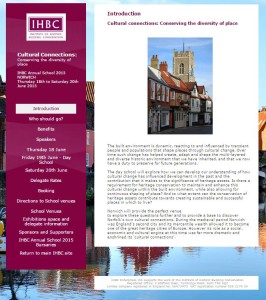 The annual conference of The Institute of Historic Building Conservation, our Annual School, is taking place in Norwich from 18 -20 June 2015, and we are delighted to announce a new keynote speaker to add to our long list of specialists: Dr Jonathan Foyle, former CEO of the World Monuments Fund (WMF) Britain, and leading author, journalist, BBC presenter, architectural historian and advocate of heritage, as well as a Visiting Professor at the University of Lincoln.
The annual conference of The Institute of Historic Building Conservation, our Annual School, is taking place in Norwich from 18 -20 June 2015, and we are delighted to announce a new keynote speaker to add to our long list of specialists: Dr Jonathan Foyle, former CEO of the World Monuments Fund (WMF) Britain, and leading author, journalist, BBC presenter, architectural historian and advocate of heritage, as well as a Visiting Professor at the University of Lincoln.
IHBC’s Director Seán O’Reily said: ‘As the former Chief Executive of the World Monuments Fund Britain, and with his unparalleled combination of international and local perspectives on the social, cultural and economic aspects of heritage already well known to his own diverse audience of twitter followers and Financial Times readers, Jonathan is the perfect person to set the scene for the entire School’s layered interrogation of conservation and diversity.’
Jonathan Foyle said: ‘The theme of this year’s IHBC school on ‘Conserving the Diversity of Place’ asks us to rethink much of what we believe heritage stands for. I’ll be speaking about how great churches were created to represent another branch of faith, how houses were built for living patterns that are now obsolete, and how industrial buildings have found new uses to survive. The game in managing that change is both preserving and contributing to character so that each stage of the life of a place supports the diverse, creative life of a community, while maintaining the best of its past.’
The IHBC’s 2015 School will explore and develop our understanding of how diversity in cultural change has influenced development in the past, and the contribution that these considerations make to the significance, care and conservation of our heritage. How does heritage conservation maintain and enhance this cultural change and diversity within the built environment while also allowing for continuous shaping of place? And to what extent can the conservation of heritage contribute to creating diverse, sustainable and successful places for living?
You can attend the conference for the full three days or choose to come for a single day, the Day School. IHBC members can also take advantage of various local and national bursary schemes to help fund attendance. The exhibition includes up to fifteen displays and the programme includes discussions, debate, and a wider range of site visits.
Details of the conference are available on the School website where you will find full information about the programme, venue and excursions.


